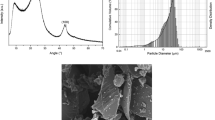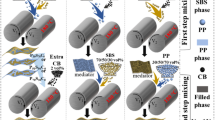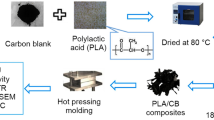Abstract
Polymer-based positive temperature coefficient (PTC) composites are of special interest because they have great potential in temperature-sensitive devices. In this work, composites based on polypropylene and carbon black (CB) particles were prepared by solution blending. The electrical and mechanical properties of composites were measured when CB particles were treated with silane coupling agent before added to the PP matrix. It was found that CB treated by coupling agent exhibited a higher filler–polymer interaction which was reflected in the improvement of the mechanical properties and the modification of electrical conductivity of composites, especially when measured against the temperature. The effect of heat treatment on the electrical conductivity, PTC behavior and mechanical properties was also studied. It turned out that the optimal heat treatment condition of composites was at 120 °C for 3 h. The differential scanning calorimetry analysis and X-ray diffraction analysis revealed that heat treatment could increase the crystallinity of composites, so that the PTC intensity increased.







Similar content being viewed by others
References
Acosta JL, Ojeda MC, Del Río C (2006) Effect of conducting fillers on the microstructure and electrical conductivity of thermoplastic polymer composites. Polym Bull 57:199–206
Yang LY, Gupta MC (2005) Novel carbon nanotube–polystyrene foam composites for electromagnetic interference shielding. Nano Lett 5:2131–2134
Tan LR, Yin CL, Huang SL et al (2014) Study of the morphology and temperature-resistivity effect of injection-molded iPP/HDPE/CB composites. Polym Bull 71:1711–1725
Isaji S, Bin YZ, Matsuo M (2009) Electrical and self-heating properties of UHMWPE–EMMA–NiCF composites films. J Polym Sci Pol Phys 47:1253–1266
Dai K, Zhang YC, Tang JH et al (2012) Organic liquid stimuli-response behaviors of electrically conductive microfibrillar composites with a selective conductive component distribution. J Appl Polym Sci 124:4466–4474
Ku-Herrera JJ, Avilés F (2012) Cyclic tension and compression piezoresistivity of carbon nanotube/vinyl ester composites in the elastic and plastic regimes. Carbon 50:2592–2598
Yuan Q, Wu DY (2010) Low percolation threshold and high conductivity in carbon black filled polyethylene and polypropylene composites. J Appl Polym Sci 115:3527–3534
EI Hasnaoui M, Graca MPF, Achour ME et al (2010) Effect of temperature on the electrical properties of copolymer/carbon black mixtures. J Non-Cryst Solids 356:1536–1541
EI Hasnaoui M, Triki A, Graça MPF et al (2012) Electrical conductivity studies on carbon black loaded ethylene butylacrylate polymer composites. J Non-Cryst Solids 358:2810–2815
Krupa I, Cecen V, Boudenne A et al (2013) The mechanical and adhesive properties of electrically and thermally conductive polymeric composites based on high density polyethylene filled with nickel powder. Mater Design 51:620–628
Nayak L, Rahaman M, Khastgir D et al (2011) Thermal and electrical properties of carbon nanotubes based polysulfone nanocomposites. Polym Bull 67:1029–1044
Bhuiyan MKH, Rahman MM, Mina MF et al (2013) Crystalline morphology and properties of multi-walled carbon nanotube filled isotactic polypropylene nanocomposites: influence of filler size and loading. Compos Part A-Appl S 52:70–79
Ameli A, Jung PU, Park CB (2013) Electrical properties and electromagnetic interference shielding effectiveness of polypropylene/carbon fiber composites foams. Carbon 60:379–391
Xu HP, Wu YH, Yang DD et al (2011) Study on theories and influence factors of PTC property in polymer based conductive composites. Rev Adv Mater Sci 27:173–183
Yui H, Wu GZ, Sano H et al (2006) Morphology and electrical conductivity of injection-molded polypropylene/carbon black composites with addition of high-density polyethylene. Polym 47:3599–3608
Xu HP, Dang ZM (2007) Electrical property and microstructure analysis of poly(vinylidene fluoride)-based composites with different conducting fillers. Chem Phys Lett 438:196–202
Shen L, Wang FQ, Yang H et al (2011) The combined effects of carbon black and carbon fiber on the electrical properties of composites based on polyethylene or polyethylene/polypropylene blend. Polym Test 30:442–448
Xu HP, Dang ZM, Yao SH et al (2007) Exploration of unusual electrical properties in carbon black/binary-polymer nanocomposites. Appl Phys Lett 90:152912
Lu C, Wang R, Hu XN et al (2014) Influence of morphology on PTC effect for poly (ethylene-co-butyl acrylate)/nylon6 blends with multiwall carbon nanotubes dispersed at interface and in matrix. Polym Bull 71:545–561
Tsao KY, Tsai CS, Huang CY (2010) Effect of argon plasma treatment on the PTC and NTC behaviors of HDPE/carbon black/aluminum hydroxide nanocomposites for over-voltage resistance positive temperature coefficient (PTC). Surf Coat Tech 205:S279–S285
Shen Y, Lin YH, Li M et al (2007) High dielectric performance of polymer composites films induced by a percolating interparticle barrier layer. Adv Mater 19:1418–1422
Xu HP, Dang ZM, Shi DH et al (2008) Remarkable selective localization of modified nanoscaled carbon black and positive temperature coefficient effect in binary-polymer matrix composites. J Mater Chem 18:2685–2690
Zhao JH, Dai K, Liu CG et al (2013) A comparison between strain sensing behaviors of carbon black/polypropylene and carbon nanotubes/polypropylene electrically conductive composites. Compos Part A-Appl S 48:129–136
Wang XJ, Liao LF, Bai WJ et al (2007) The effect of heat treatment on crystal structure and mechanical properties of PP. Plast 40:61–64
Acknowledgments
This work was supported by the National Natural Science Foundation of China (No. 21174063), the Natural Science Foundation of Jiangsu Province (No. BK20131358), the Aeronautical Science Foundation of China (No. 2011ZF52063 and No. 2014ZF52069), and the A Project Funded by the Priority Academic Program Development of Jiangsu Higher Education Institutions (PAPD).
Author information
Authors and Affiliations
Corresponding author
Rights and permissions
About this article
Cite this article
Ding, X., Wang, J., Zhang, S. et al. Carbon black-filled polypropylene as a positive temperature coefficient material: effect of filler treatment and heat treatment. Polym. Bull. 73, 369–383 (2016). https://doi.org/10.1007/s00289-015-1492-3
Received:
Revised:
Accepted:
Published:
Issue Date:
DOI: https://doi.org/10.1007/s00289-015-1492-3




